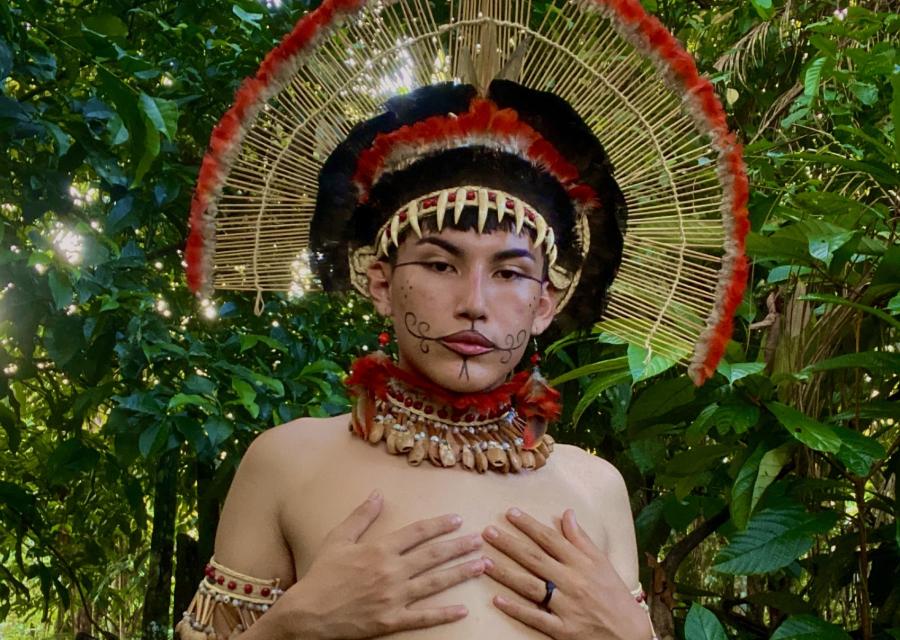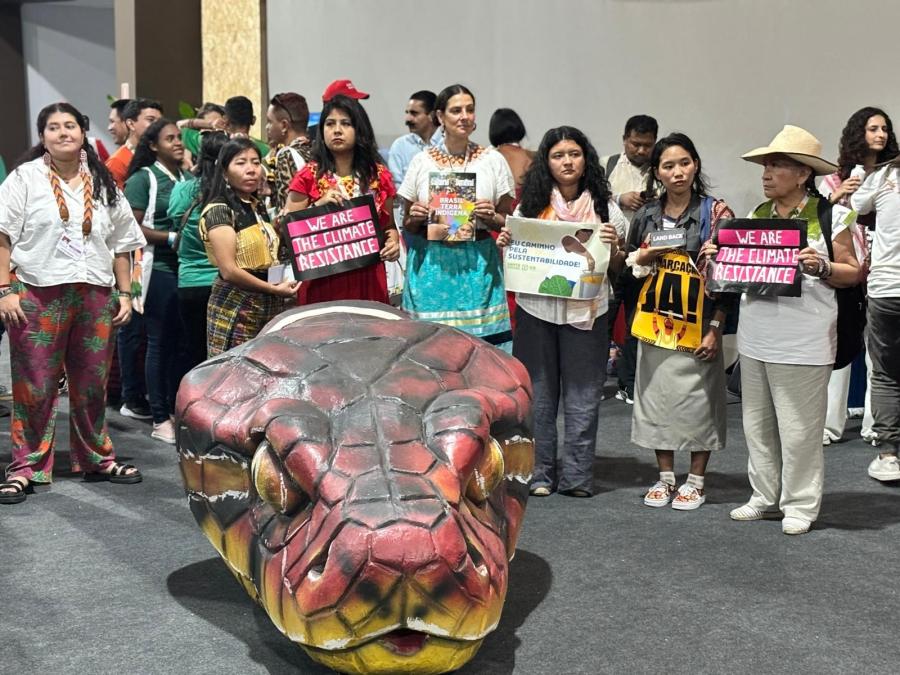As late as 1980, Brazilian Indians had not organized themselves in any coherent political movement, either at the local or at the national level. Reasons for this include: Brazil's gigantic size (3,286,170 square miles) which aggravates the physical and financial difficulties of transportation and communication between remote Indian areas; the extensive dispersal of indigenous peoples through virtually all states of the Union; the fragmentation of Indian societies (a population of about 300,000 individuals organized in over 200 peoples) into different languages, customs, and degrees of interethnic contact; and the form in which the Brazilian state has carried out its Indian policy. Officially, and very often in actual practice, the government has had total command over indigenous communities. The political isolation of most Indian peoples is a consequence of the often police-like control over movement in and out of the reserves, and of the appalling deficiency of education. Without access to proper schooling, the indigenous peoples in Brazil have not learned sufficient Portuguese to operate in national society with minimal proficiency. Even so, and against all odds, indigenous peoples in Brazil have been experimenting with various forms of organization, albeit backed up by non-indigenous support groups.
Indigenous Assemblies in the 1970s
The Catholic Church was the prime force in launching a supra-local indigenous political movement. The Indigenist Missionary Council (Conselho Indigenista Mission, CIMI) was created in 1972 as a militant branch of the National Conference of Brazil's Bishops (CNBB). It grew out of the deep engagement of Catholic Church members in Liberation Theology, along the lines that inspired the urban "Base Ecclesiastic Communities," as well as the rural land Pastoral Committee. Two years later, CIMI organized the first of a long series of "indigenous assemblies." By providing, or substantially covering transportation, food, and lodging expenses, the missionaries brought together representatives of several indigenous groups to participate in informal gatherings. It took place in April 1974 in the state of Mato Grosso and was attended by 17 Indians. The second, in May 1975, was called by the Munduruku Indians of the Cururn Mission with the presence of 60 Indians. From then on, the number of meetings and of participants increased every year.
The thrust of the meetings was to expose each indigenous representative to the interethnic experience of other groups and to convey these messages to their own communities. The initial phase was one of mutual discovery. Each Indian listened to the others recount aspects of their respective cultures, as well as the routine of abuses and plunder on the part of private or official enterprises. The astounding similarities in the way group after group suffered in the hands of whites struck a resonant chord in the listeners' consciousness. The sense that the same troubles also plagued other Indians they had never seen before generated a sense of solidarity and confidence that they were not alone in their plight. A new world of generalized injustice opened up to them, creating an esprit de corps which persisted well after the gatherings were over. The speeches delivered during the early meetings were addressed to fellow Indians in a direct exchange of misfortunes, unlike later phases in the movement when Indian leaders spoke directly to the white man. Many indigenous representatives at these CIMI assemblies complained bitterly of their own inability to communicate with their co-participants, while several monolingual leaders had to have their speeches translated as they spoke in their own languages. More than ever before, it became evident that keeping the Indians illiterate was one way of retaining control over them.
As indigenous awareness expanded beyond strictly local problems, assemblies moved from regional, particularly in the north, northeast, and center-west, to national level. Consequently, they began to attract the attention of authorities, among them officials of the National Indian Foundation (FUNAI) who outright opposed CIMI's organizing efforts. During the military regime, several assemblies were disrupted by the federal police or by FUNAI. The 1978 attempt by the Geisel government to terminate the Indians' special status, in what became known as the "emancipation decree," propelled those first organizing efforts toward a pan-Indian movement.
As CIMI continued to promote meeting after meeting in various parts of the country, in April 1980, an independent group of young Indians who attended school in Brasilia proposed the creation of a nation-wide indigenous organization they called UNIND (Uniao das Naçoes Indígenas). These students belonged to groups such as the Terena, Xavante, Bororo, Patashó, and Tushó. Their intention was to organize indigenous efforts around the issue of a better indigenous policy Less than two months later, an Indian assembly in the town of Campo Grande (state of Mato Grosso do Sul) ended with the founding of UNI, another version of the Uniao das Naçoes Indígenas, which would "promote the Indians' autonomy and auto-determination, reclaim and guarantee the inviolability of their lands, and assist the Indians in knowing their rights by drawing and putting into practice cultural and community development projects." One month went by and another meeting was attended by representatives of 15 "Indian nations" to discuss the "Creation of the Brazilian Indigenous Federation." The participants pledged allegiance to UNI, now considered to be the outcome of the fusion of Brasilia UNIND with the Mato Grosso do Sul federation. The inven-tion and re-invention of UNI under different promoters attest to the ripeness and even urgency of the idea of a pan-Indian organization.
The Union of Indian Nations in the 1980s
In the 12 years of its existence, UNI went through several leadership crises, changed its format from a hierarchical presidential system to an encompassing organization of national and regional coordinators. The UNI made and broke alliances with the Church, with non-Indian NGOs, and with the so-called "Alliance of the Peoples of the Forest" which included non-Indian rubber gatherers in Amazonia. The organization challenged the open hostility of a strong, militarized state which repelled the idea of having nations within the nation and organized in a Union.
When the name "Union of Indian Nations" was first heard in Brazil, there was an immediate reaction from the government. Repression took various forms. The strong man of the military regime, General Golbery do Couto e Silva, ordered that "profound studies" be carried out to examine not only the convenience of the establishment of a Union of Indian Nations, but also its legality, considering that the Indians are "relatively incapable" and wards of the state. The profound studies by the National Intelligence Service (SNI), the notorious agency which promoted repression of civil society during the military regime, mentioned the "grave inconvenience of indigenous nations being brought together under an entity whose organization is already being undertaken with the `protection' of people reputedly dedicated to set the Indians against the indigenous policy defined by the Government." SNI also recommended an immediate revision of the 1973 Indian Statute so as to curb "situations as absurd as" the formation of a pan-Indian organization by "relatively incapable" Indians, or having an "obviously integrated" Indian raise polemic issues in the press, unwilling to give up his "penal irresponsibility but wanting to leave the country to join a `tribunal' abroad."
During the 1987-88 Constitutional Assembly, UNI was supported by several non-Indian organizations including the Brazilian Anthropological Association (ABA), and the National Association of Geologists (CONAGE). Their involvement was greatly responsible for the effective indigenous lobby which brought the Indians some palpable gains, such as the deletion of the integration principle that had since prevailed.
It was also during the Constitutional Assembly that UNI and CIMI fell out around the expression "Indian nations." UNI and its allies, aware of the antagonism that the term generated, and fearing that to insist on it might jeopardize more important concerns, omitted it in their "popular amendment" and used "peoples" instead. As it turns out, "peoples" is also banned from the state's indigenous vocabulary, as it evokes self-determination and hence, a threat to the country's sovereignty. This left only politically innocuous alternatives such as "indigenous societies," or "indigenous populations." CIMI insisted on keeping the name "Indian nations" which incurred the fury of the most conservative sectors of the country, and put at risk the success of the entire indigenous lobby in a violent campaign that accused the Church of using the Indian issue to sell Brazilian mineral resources to foreign interests. The rift that ensued between CIMI, UNI, and some lay NGOs was never mended.
UNI's eventual demise did not come as a surprise. It never resolved the problem of its representation or the top-heavy distortion in its management. It never succeeded in mastering the ethnic reality of indigenous Brazil with its multitude of small, scattered, and often politically detached societies. One gets the impression that the budding Indian movement, including UNI, directly reflected the organizational form in which official indigenous policy has been carried out. Just as the latter flows from the top down, that is, from whites to Indians, the indigenous political consciousness emerged having outside efforts as the starting point. First, CIMI's role was fundamental in offsetting one of the biggest barriers to raising consciousness, isolation and lack of material means to travel. The "cosmopolitization" which resulted from CIMI's pedagogical experiment worked as a trigger for future indigenous initiatives. After CIMI's pioneer role, a pan-Indian organization was founded and stimulated by whites.
This organization turned out to be an important platform to launch the Indian issue onto the field of national politics. More recently, NGOs, both national and foreign, have produced a similar effect in precipitating political action on the Indians' behalf. During these efforts, the impetus has come from outside indigenous communities. In contrast to indigenous movements in other Latin American countries, the first Brazilian Indian organization was neither local nor regional, but national. The attempt to create regional UNI chapters failed to bridge the gap between headquarters (whether in Brasilia or Sao Paulo) and grassroots. Whatever concerted action there might have been at the beginning between national UNI and the regional UNIs, it did not last long and national UNI turned out to lead a separate life of its own. Thus, there were no intermediate organizations that might coordinate actions and translate the policy and procedures of national UNI to the local communities. There was no confederation effect of smaller organizations into a broader unit. The problem of legitimacy that plagued UNI derived mostly from this skewed arrangement.
The Fragmented Globalization of the 1990s
The age of white NGOs has brought along a new era for the indigenous movement not only in Brazil, but perhaps everywhere in the world. In the Brazilian case, until the early 1990s, the Indians had to count on NGOs to have access to political and economic channels. As we have seen in UNI's case, indigenous political organizing was carried out in conditions of tacit illegality. Constricted by the abusive application of state wardship, the Indians were put in the uncomfortable position of virtual creatures of NGOs-a sort of private wardship. The present decade has delivered a new model for interethnic politics. We now see a dramatic change in the balance of forces between Indians and friends of the Indians. In Brazil, the international distribution of funds to legally organized entities is coupled with the constitutional provision which empowers indigenous peoples to organize themselves regardless of state wardship. The result has been an unprecedented proliferation of indigenous organizations, especially in Amazonia.
It is as if the lesson learned from the UNI experience has resulted in the opposite extreme. Against 30 support groups run by whites, both lay and religiously oriented, there are now no less than 109 indigenous organizations ranging from very local (Indigenous Association of the Terena of Cachoeirinha, AITECA) and regional (Association of the Indigenous Peoples of Roraima, APIR) to "common interest" associations (National Union of Indigenous Women, UNAMI). There is also a national entity, CAPOIB (Council for the Articulation of Indigenous Peoples and Organizations in Brazil), which aims at coordinating all the others, apparently with no decision-making powers.
Whereas the UNI model directly reflected the non-Indian part of the politics of contact- initial non-Indian impetus, hierarchical management, and discontinuity between the national and the local levels-the pattern of multiplying entities appears to more closely echo the social reality of indigenous Brazil: a profusion of small societies, living relatively independent lives, with few common concerns apart from the underlying predicament of being Indian in a country which strongly favors cultural homogeneity. But this apparent mimetic correspondence with indigenous social reality should not distract us from perceiving a recast of the contemporary NGO pattern, a fragmentation of interest groups legally apt to secure funding for specific projects, most of them economic. Nevertheless, while going from one extreme to the other, the Brazilian Indian movement is more than a merely reactive response to external conditions and stimuli. In the process of searching for its political vocation, the Brazilian indigenous movement has experimented with some original courses of action which can by no means be attributed to outside involvement. One should bear in mind that indigenous peoples have a long experience of walking straight on winding trails. What may look like idle wanderings to a Western mind may actually represent the shortest way between two points, providing us with surprising lessons in creativity.
References
CEDI. 1981. "Surgimento das organizacoes indígenas." Povos Indígenas no Brasil 1980. Aconteceu Especial 6:38-39. Sao Paulo: Centro Ecuménico de Documentaçao e Informaçao.
----.1991. Povos Indígenas no Brasil 1987/88/89/90. Aconteceu Especial 18. Sao Paulo: Centro Ecuménico de Documentaçao e Informaçao.
Cordeiro, Enio. 1993. Politica indigenista brasileira e promoçao internacional dos direitos das populaçoes indígenas.Brasilia: Ministerio das Relacoes Exteriores.
Fisher, William. 1994. "Megadevelopment, Environmentalism, and Resistance: The institutional Context of the Kayapó Indigenous Politics in Central Brazil." In Human Organization. 53(3): 220-232.
ISA. 1996. Povos Indígenas no Brasil 1991/1995. Sao Paulo: Instituto Socioambiental.
Ismaelillo and Robin Wright, eds. 1982. Native Peoples in Struggle. Cases from the Fourth Russell Tribunal & Other International Forums. Bombay, NY: Anthropology Resource Center (ARC) and Emergency Response International Network (E.R.I.N.).
Jackson, Jean. 1991. "Being and Becoming Indian in the Vaupes." In Nation-States and Indians in Latin America. Greg Urban and Joel Sherzer, Eds. pp. 131-155. Austin: University of Texas Press.
Juruna, Mario, Antonio Hohlfeldt, and Assis Hoffmann. 1982. O Gravador do Juruna. Porto. Alegre: Mercado Aberto Editora e Propaganda Ltda.
Ramos, Alcida Rita. 1994. "The Hyperreal Indian." Critique of Anthropology. 14(2)1153171.
----.forthcoming. Indigenism: Essays on the Politics of Interethnic Contact in Brazil. Madison: University of Wisconsin Press.
Turner, Terence. 1991. "Representing, Resisting, Rethinking: Historical Transformations of Kayapó Culture and Anthropological Consciousness." In Colonial Situations. Essays on the Contextualization of Ethnographic Knowledge. George Stocking Jr., Ed. pp. 285-313. Madison: University of Wisconsin Press.
Article copyright Cultural Survival, Inc.



